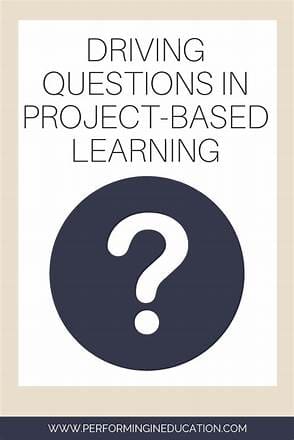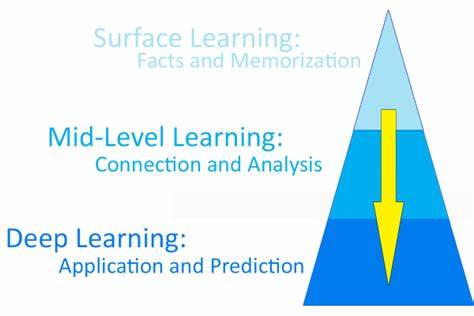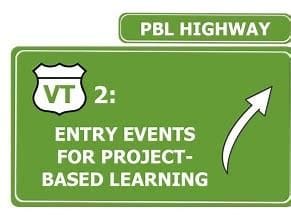
Design PBL with Clarity
Rigorous Project Based Learning by Michael McDowell Video
Michael McDowell, author of Rigorous PBL Design, suggests 5 steps to ensure students can answer where I am going in my learning:
Step 1: Prioritize key learning intentions.
Step 2: Create success criteria at surface, deep, and transfer levels.
Step 3: Design driving questions that align with learning intentions and success criteria, and identify contexts.
Step 4: Develop multiple tasks that align with surface, deep, and transfer learning levels.
Step 5: Develop an entry event to orient learners to learning intentions and success criteria.
To review Design Phase One: How to Shape Project Design With Great Clarity
Focus on Key Learning Intentions

Learning intentions explicitly describe what students should know (i.e. content) and do (i.e. skill). It serves as “end in mind” and the focal point for teachers and students to refer to during projects.
McDowell recommends teachers focus on essential standards deemed necessary for students to learn at the surface, deep, and transfer levels. Teachers need to focus on those standards or learning intentions critical for students to know and do.
McDowell provides questions to help teachers determine those intentions that all students must know at surface, deep, and transfer levels.
Determining Quality Learning Intentions:
- Will the outcome provide students with knowledge and skills beyond a test date?
- Will the learning outcomes provide knowledge and skills valuable in multiple disciplines?
- Will learning intention(s) provide the essential skills for success at the next grade level?
- Will students address content aligned with state standards and considered important to local and global stakeholders and communities?
- Do students have the prerequisite knowledge to meet the challenges?
- Will the learning outcome reemerge in the subsequent units and courses?
- Does the knowledge and/or skill base require a level of understanding typically implied in expository and narrative texts?
Below is a third-grade example of ELA learning intention provided by McDowell:
Project 4: Fables, Futures, and Forecasts
Level: Third Grade
Subject: English Language Arts
The following project requires students in the third grade to develop their writing skills by developing an opinion piece that includes a viewpoint with a clear reason. To receive full marks on the final product, students must clearly convey their ideas and provide thorough and correct evidence that supports their opinion. To be effective, the project must focus on the targeted skill sets, while using students’ knowledge gained in earlier years to ensure they are concentrating on learning new writing techniques, rather than the unfamiliar context. In the second grade, students recounted stories including fables and folktales from diverse cultures, and determined their central message, lessons, or morals. This project relies on the students’ background knowledge of this genre of literature.
The conclusion of the project requires students to conduct an author’s speak, where they present their writing to a group of parents, community members, teachers, and peers. The presentation includes questions and answers in which students must discuss how they conducted their research and reached a viewpoint. After the presentations, the teacher tasks students with writing a brief opinion piece on other subjects of interest linked to the students’ prior knowledge.
McDowell points out teachers should focus only on the knowledge and skills they expect students to learn. Include no tasks or products in the learning intention description. Products or tasks are how students display their understanding of learning intention, according to McDowell.
Here is an important point to remember:
“Learning intention should focus on the key understanding of skill, not specifically on the way to demonstrate understanding.”
For example, if students must learn to write a persuasive text, the learning intention should simply be “We are learning to write a persuasive text.”
Create Success Criteria at Surface, Deep, and Transfer levels

To create success criteria, teachers need to arrange the concepts and skills of the learning intentions into the categories of surface, deep, and transfer:
Surface, Deep, and Transfer Success Criteria Categories
Surface: Students understand single and multiple facts, details, and basic skills. Students ask, what are the ideas I need to know for the learning intention? What are the skills I need to know for this learning intention?
Deep: The second category is related to the linkage or relationships between ideas and skills that students must understand or apply. Students ask, what are similarities and differences between the ideas? How do I relate skills? What connects and what appears in direct contrast? Are there ideas that somewhat relate? How so? Are there recurring ideas, skills, or events that make up principles or main ideas in the subject?
Transfer: Finally, the last category is related to the extension of the relationship of ideas to other contexts (“deep”). Students ask, what are ways to apply the ideas and relationships between ideas to outside contexts? How do I apply these skills to a new task or environment?
For example, Learning Intention and Success Criteria for Project 4: Fables, Futures, and Forecasts:
Project Design
Step 1: Learning Intention(s)
- I can write and support my opinion on a topic.
- I can write on a topic that conveys information clearly.
Step 2: Success Criteria
- Use because, therefore, since, and for example to opinions and reasons.
- Sequence reasons, opinions, and points of view in own writing and in text.
- Connect facts, definitions, and details to back up opinion.
McDowell recommends remembering these points:
- Learning intentions and success criteria are void of task-specific requirements (i.e. no assignments, project products, etc.) are described, and context (i.e. project situations are not described in success criteria).
- Success criteria are directly aligned with specific levels of learning complexity (surface, deep, and transfer). McDowell stresses this step is critical in PBL, as students face all levels of surface, deep, and transfer expectations on the first day of class when they receive their entry event.
Design driving questions that align with learning intentions and success criteria, and identify contexts

Two key parts of driving questions:
- learning intention
- the specific context in which students are expected to develop surface and deep level understanding to apply the learning intention
Driving question provides a reason for students to know specific learning intentions at surface, deep, and transfer levels. It places students into a certain situation or context that enables them to see the core purpose of the learning intention outside of a classroom.
For example, from Project 4: Fables, Futures, and Forecasts:
Step 3: Driving question
How do we use lessons (learning intention) to convey in the stories of our youth to [develop classroom rules] (context)?
Context
Classroom rules, study habits, understanding others, developing friendships, future goals and actions, predict our future based on our decisions.
McDowell suggests that when designing driving questions, remember these points:
- Driving questions need to specify learning intentions and the context. Driving questions orient students to specific academic goals of the discipline(s) and a particular situation or context. The aim of our work in learning is for students to transfer their surface and deep understanding to multiple situations. So it is critical that students readily contrast the learning intentions and success criteria from the project context.
- Driving questions evoke transfer expectations: Driving questions aim at higher-order learning expectations and require teachers to support students in understanding the surface and deep success criteria required to meet such expectations.
Develop multiple tasks that align with surface, deep, and transfer learning levels

McDowell notes that once learning intentions, success criteria, and a driving question have been developed, a wealth of tasks should be created and aligned with surface, deep, and transfer success criteria.
McDowell suggests a broader array of tasks and assessment types should enable teachers and students to have choice in ways to convey understanding. Simultaneously, teachers should make sure most tasks include plenty of opportunities for students to read, write, and talk.
Students should think about the content and skills embedded within the product. Students need to focus their time and effort on thinking deeply about the disciplines of business, culinary arts, civics, and biology before they create a product that honors the knowledge of a profession. One way to do this is for students to focus on reading, writing, and talking. It enables students to build core competencies, resulting in surface-, deep-, and transfer-level understanding and skill.
To support teachers in this effort, Project 4 Fables, Futures, and Forecasts illustrates an example of surface, deep, and transfer tasks that require students to read, write, and talk about learning intentions and success criteria.
Step 4: Tasks
Surface
Identify connecting words in texts.
In dyads, practice sharing and backing up opinions with facts.
Deep
Write paragraphs that sequence reasons, opinions, and points of view.
Develop a narrative organizer that relates details to specific opinions.
Review texts for connecting words, points of view, and related reasoning.
Transfer
Develop an opinion piece.
Use because, therefore, since, for example.
Identify reasons, opinions, points of view in texts and own writing.
Link because, therefore, since, and for example to opinions and reasons.
Sequence reasons, opinion, and points of view in own writing and in text.
Connect facts, definitions, and details to back up opinion.
Write an opinion piece that includes a clear reason, with details, definitions, and facts to enable others to understand your ideas.
Develop an entry event to orient learners to learning intentions and success criteria

Develop an entry event to orient learners to learning intentions and success criteria is the final step in ensuring clarity of learning expectations and success criteria for students.
McDowell reviewed what we have done so far in the design phase I of PBL:
“PBL introduces clear learning intentions and success criteria at the beginning of the learning sequence. In particular, during Phase 1 (i.e., Project Launch), teachers introduce students to the surface, deep, and transfer expectations that they will need to address during the project. By providing an overt articulation of expectations early on, students have a clear picture of where they are going over the next several weeks.”
So, entry event serves to launch the learning sequence and provide students with the critical information they need to move from surface- to deep- to transfer-level learning. Specifically, the entry event introduces the learning intentions and success criteria, driving questions, the context of the problem, and task expectations. The entry event is typically written by the patron, who requests help in answering the driving question.
Step 5: Entry event
Project 4 Fables, Futures, and Forecasts
Context — Third grade classroom
Expectations — Develop an opinion piece.
Patron — School community
Format — Written piece and public presentation, including a Q & A
Conclusion
Michael McDowell sums up best:
“The steps in project design are necessary to improve student and teacher clarity and, correspondingly, student achievement and confidence. Because projects and problems are initiated in the classroom to students at the transfer level, it is paramount that learners have the support necessary to meet surface and deep requirements to achieve transfer-level demands. This requires the following: students can separate context from learning intentions; learners have a clear understanding of surface to deep to transfer criteria; a driving question provides transfer-level opportunities; tasks are rich in reading, writing, and talking; and an entry event frames their learning. This level of clarity of expectations will enable students to better progress toward established goals and address a multitude of problems outside the one offered in the class by the teacher—which is the ultimate goal of transfer.”
I have created a Project Design Template like McDowell’s.
The clarity with design Project Based Learning has to start with How To Write Driving Questions That Drive Projects Learning Make sure driving questions are correctly designed using the 5 steps suggested in the post,
